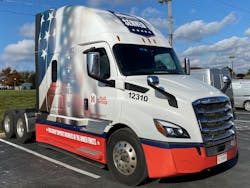Equipment standardization breeds efficiency at Hub Group
“One of the best strategies we can employ for shop productivity and efficiency is to standardize our fleet’s equipment,” said Gerry Mead, executive vice president, maintenance & equipment at Hub Group. “Operating different makes, models and specs adds complexity to maintenance. Standardization lets us become experts at what we do and reduce training and parts needs.”
Service for the Hub Group fleet of 3,000 power units and 6,000 trailers is provided by 36 technicians at six shops in California, Texas, Tennessee, and Georgia. Some of the shops also have fully equipped field mobile service trucks to meet customer demands.
“To operate our shops as efficiently as possible, every tractor is sent to a [preventive maintenance] bay where we use laptops with dealer-level diagnostic software,” Mead related. “At the same time, a Lite-Check tool is used on trailers to quickly assess electrical systems and all units are aligned with a Hunter six-wheel, three-axle system, which we feel is critical for reducing fuel use and tire wear. A brake bleed down test is conducted as well.
“If a unit needs a repair it is moved to a different bay,” Mead continued. “That keeps vehicles moving through our shops, and with this way of organizing service activities we can perform a better quality PM, which reduces costs and lowers downtime. Improving shop throughput means our assets can cover more revenue producing miles.”
Parts strategies
Shop layout also contributes to efficiency and productivity, Mead noted. “We place tools and parts so technicians don’t waste time walking back and forth,” he said. “In addition, bays used for faster repairs are closer to the parts room. We’re also cutting the need for technicians to leave their bays by using carts to deliver parts. The result has been an improvement in direct labor costs and quicker turn times.
Another cost saving practice at Hub Group is a centrally managed parts inventory. The fleet employs a corporate parts manager who uses OEM and aftermarket fleet programs, and works with local dealers, to meet parts needs. A mounted tire and wheel program from Michelin is also in use.
“Centralized sourcing programs give us greater purchasing power, which lowers our parts costs,” Mead stated. “We also organize parts rooms by VMRS code. It saves a lot of time when things are sorted correctly.”
Technicians wanted
One thing that Mead said is currently inhibiting Hub Group’s maintenance operation is the need for qualified technicians. “We now have 11 openings and technicians are as hard to find as drivers,” he pointed out. “To address that we’ve developed relationships with technical schools near our facilities and we’re using online employment sites and agencies. We’re also working to attract military retirees.
“Needing technicians limits our ability to handle all of our maintenance in-house, which is more cost effective,” Mead continued. “Still, establishing and running a company shop is a matter of looking at the ROI for brick and mortar facilities. For example, we recently opened a new shop in Georgia after analyzing the quantities of equipment we can service at that facility.
“While we address those issues on an ongoing basis, we do outsource to a select group of vendors,” Mead added. “We work with several vendors, all of whom must go through our qualification process and meet our standards, plus they closely follow the written protocols we’ve established.”
Emphasis on uptime
The goals in all cases for Mead are to get assets back on the road quickly and eliminate failures between PMs. To evaluate that performance, he noted, it’s essential to have information that can be used to make informed decisions.
“Fleet maintenance is a data driven business,” Mead stated. “We use VMRS extensively to get accurate data to measure direct and indirect labor productivity. We perform time studies of in-house PMs and measure facility throughput based on hours of downtime. We’re in the freight hauling business and utilization is how fleets generate revenue. Understanding and addressing cost factors tells us about our weaknesses and how we can improve our maintenance operation.
“We subscribe to a maintenance bill of rights that addresses the right specs, the right people, the right training, the right parts and the right tools and facilities, right now,” Mead said. “With all those rights you can’t go wrong.”
About the Author

Seth Skydel
Seth Skydel, a veteran industry editor, has more than 36 years of experience in fleet management, trucking, and transportation and logistics publications. Today, in editorial and marketing roles, he writes about fleet, service, and transportation management, vehicle and information technology, and industry trends and issues.

